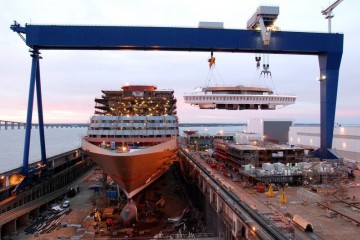The dominant paradigm in container shipping is “economies of scale”, but we might be heading for a paradigm shift. Away with mega-carriers, mega-ships and mega-ports! Instead:
- Smaller carriers with fewer assets, less debt, more flexibility; carriers that actually compete with each other.
- Smaller ships to provide more tailor-made solutions to customers.
- More ports called, also to smaller ports with their own local catchment areas, rather than hub and spoke plus long land transport legs.
How could this happen? Five possible drivers.
First, look at the flows. Intra-Asia containerized trade is already four to five times bigger than the Asia-Europe or Transpacific trade. Mega-ships only make sense over long distances: you need a relatively large number of sea days to make the business model work. The rise of intra-continental flows and near-shoring does not rhyme with more mega-vessels. It is the smaller players with the smaller ships that make the profits here.
Second, shipping lines might realize this and be considering new models. In a press message last summer that went relatively unnoticed, Maersk Line seems to suggest this. They ordered a series of 14,000 TEU ships that they would like to deploy everywhere, rather than one specific route. Quite a difference from the classical approach of ordering the largest ship for the Asia-Europe trade and cascading down the redundant ships to other trade lanes.
Third, disruptive change will come from wider application of information technologies. Information reduces the need for middlemen. Supply chains could become shorter and see more direct transactions. We will just have to wait for the Uber of ocean shipping. So, a business model in which mega-assets are a burden rather than an advantage.
Fourth, and related to this: more direct links between buyers and sellers. Large shippers could organize their transport themselves. Which would mean: smaller quantities transported, smaller ships, more direct port calls.
And fifth, regulators might wake up. After all, allowing the concentration of mega-carriers, giving taxpayers’ money to build up ports, freight corridors and an enormous bubble of mega-ships for a sector that imposes its standards to the whole transport chain without prior discussion, does not create jobs and has been fairly passive on corporate social responsibility – does not exactly sound like a very good deal for politicians.
Add up these five drivers and ask yourself: what does it imply? My impression: we might be up for a perfect storm.
6 Comments
Comments are closed.




Fascinating and inspiring analysis. It used to be that we asked “where is the EasyJet of the shipping industry?”, i.e. another asset based player. Now we are asking “where is the Uber of the shipping industry?”, i.e. a non-asset based player – a new disruptive middleman. It is the middlemen, who understand what customers want much better than any of the asset owners, that will drive the paradigm shift and shape the future. The leading freight forwarders (also middlemen) have been doing this upto now and they have the profits to show for it.
Olaf,
One additional aspect is the “Economy of Scale” asset’s true utilization, and the network it is a part of. More containers spread fuel and crew costs, but the congestion in the ports and the roads/rails bringing in the containers has congestion and down time not measured at the ship.
Lee
Hello Olaf , ” Third wave” is yet to hit the shipping giants, all the containers carriers must move from mass base port calls to mass customized call near to producers & consumers. Large ports & large ships are inflexible to rapidly shifting production & consumer patterns. Most of the countries inland haulage is more expensive than base freight, this is primarily due to large base ports away from producing & consuming locations !
Great Information about Shipping.Thanks for sharing.
This begs to be compared with the airline industry. The A380 megaplane hasn’t sold nearly what was expected because it is only useful on Long distance travel between the very large hubs: smaller aircraft are selling very well indeed because the carriers make more money on point-to-point flights between moderately sized cities/destinations because it’s vastly more convenient to fly from Cleveland to Miami directly rather than have a 3 hour layover in Charlotte or even worse, Chicago (because Chicago is the wrong way).
Route planning is an art within the Airline industry that can make or break a company…
I am very glad to see your post as you have shared great information about shipping industry. Thanks for sharing!